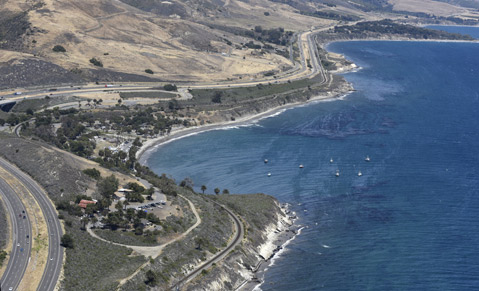Refugio Oil Spill: 37 Days In
Cleanup and Investigation Continue, Claims Come In, PHMSA Answers Electeds

Plains All American Pipeline is on the hook for about $92 million in cleanup efforts, officials announced at a Wednesday press conference. The media event mimicked the dozen or so held the week after the May 19 Refugio Oil Spill — a handful of agencies representatives made brief statements to reporters before fielding questions.
But 37 days after Line 901 ruptured, many of those questions, including exactly when and where cleanup vessels arrived, remained unanswered. U.S. Coast Guard Captain Jennifer Williams said officials responded within the first 12 hours on May 19, and the number of personnel mushroomed to more than 1,100 cleanup crew members on the ground and about 350 people packed in the Unified Command post at the height of the response. This week, that number leveled to about 1,000 personnel total.
Likewise, officials could not elaborate on the news this week that samples of tarballs found about 100 miles south at Manhattan Beach matched sources from the spill. Williams said the testing process is complicated and being completed by the Department of Fish & Wildlife’s Office of Spill Prevention and Response. Not all the results have been released because they are part of the ongoing investigation, she said, emphasizing that the Unified Command does not focus on this aspect, and the test results will not change the cleanup procedures. Plains also did its own testing and publicized that two South Bay samples matched sources from the spill.
Cleanup crews will be seen on the beaches “until the job is complete,” Williams said. She elaborated that 93 percent of cleanup goals have been met, adding that the last 10 percent are always the “most tedious.” Officials did provide a number of before and after photos, along with a general timeline of general phases.
The fishery closures — about 20 miles along the coast and six miles out to sea — remain in effect until lab results from the Office of Environmental Health Hazard Assessment show the toxicity values for chemicals of concern are low enough.
Stories of angry fisherman who are losing out on profits have been common. Residents or businesses can file claims against Plains. On Wednesday, Plains executive Pat Hodgins would not say how many claims have been submitted, citing confidentiality as the reason. He went on to say it would be “inappropriate for me to discuss the investigation.”
Last month, Congressmember Lois Capps and Senators Dianne Feinstein, Barbara Boxer, and Edward Markey wrote a hard-hitting letter to Plains All American Pipeline CEO Greg Armstrong, demanding answers about pipeline safety equipment, the official timeline of response efforts, the inspection results from May 5, 2015, and the discrepancy between those preliminary results and recent investigation that revealed corrosion metal loss was actually much worse.
In a letter dated June 19, Plains outlined previously reported information: The pipeline was remotely shut down at 11:30 a.m.; the Santa Barbara County Fire Department received a 9-1-1 call at 11:42 a.m.; just afternoon, State Parks staff were alerted to the 9-1-1 call and attempted to locate the source of the odor; Plains employees were about two miles away at a spill drill at Freeport-McMoRan’s facility; shortly before 12:30 p.m., the Fire Department personnel notified the county emergency office that oil was on the beach; at 12:43 p.m., the National Response Center received the first notification of the spill; “shortly thereafter,” Plains staff witnessed the oil on the water; at 1:25 p.m.-1:30 p.m., Plains employees visually confirmed the spill originated from Line 901 and subsequently made various cell phone calls to “mobilize resources, make notifications, and coordinate activities”; at 2:56 p.m., Plains employees in Bakersfield called the National Response Center and formally notified them of the coordinates of the release. Read the full letter here.
The elected officials also wrote letters to the Pipeline and Hazardous Materials Safety Administration (PHMSA) deputy administrator Timothy Butters. Interim director Stacy Cummings responded, describing the actions PHMSA has taken to limit and investigate the incident, as well as describing work conducted from Plains’ control room in Midland, Texas. She stated that PHMSA left it up to pipeline operators to decide where and if to install emergency flow restrictors and informed the elected officials that PHMSA did not have the in-line inspection reports. The agency was reviewing them over a “secure electronic site,” she wrote, and an independent third-party was reviewing those reports and others of repair of “anomalies.” Read the letter here.
The issue of natural seepage also came up. Williams said that in the first couple of days, helicopters overhead could notice where the natural seeps were and track the oil washing up on the beaches. As a matter of caution, Williams said, the cleanup crews collected all washed up oil. The collected oil was separated from soil and water and transported for proper disposal.
On Friday, El Capitan State Beach will be reopened. It’s still unclear exactly when Refugio will open again.


